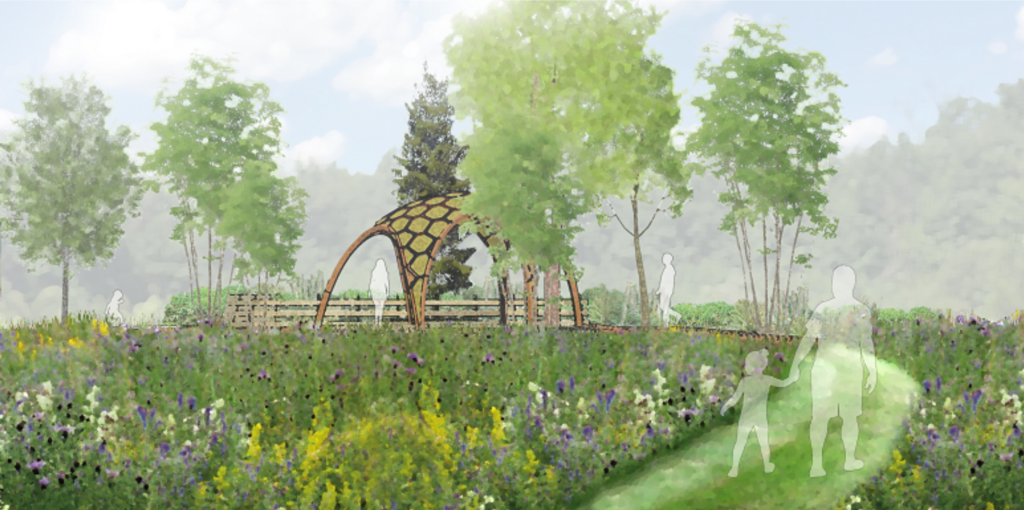
The use of different levels is always an effective way for small show gardens to make the space feel bigger and to create views that are not possible on the level: Joe has put at the heart of the garden a sunken seating area that is backed by a ‘living’ wall and sheltered by the main focal point, an organic mushroom-shaped ‘pavilion’. Down here there is a sense of enclosure, calm and quiet amongst the trees. The soil dug out from the centre has been used to fill a higher area of woodland, and create a riverbank that dances with meadow style planting.
I was fortunate to be on the planting team and help put together Joe’s vision for naturalistic plantings that emulate different plant communities. Overshadowing the back of the garden, an impressive Pseudotsuga menziesii (Douglas Fir) above a tapestry of shady green foliage represents the woodland. The floor is punctuated with spiky ferns Dryopteris and Blechnum, and at the edges the dramatic flower spikes of Digitalis purpurea and Acanthus mollis almost reach the tree’s branch tips. Smaller shrubby species are planted around the tree’s trunk, and even in this small space the perspective gives the appearance of a clearing within the woodland. A soft coral- coloured Geum livens the edge of the woodland where it meets wild strawberry and abundant plantings of a moss-like perennial, Selaginella kraussiana.
The wildflower meadow is naturalistically planted with grasses, species gladioli, Echium, Ornithogalum, Centaurea cyanus ‘Blue Boy’ and Silene dioica all in cooler colours, punctuated with a gorgeous deep purple-black Papaver somniferum.

But it is the transitions between these areas where Joe’s skill is evident - it takes a clever plantsman to move from woodland to meadow without the shift being contrived. Joe uses ‘woodland edge’ plants Digitalis, Aquilegia, Gillenia and Carex, adding Anthriscus, Daucus carota, Geranium, Nectaroscordum, as he moves into the light, finishing with Echium vulgare, Briza media, Carex and Silene dioica reflecting the meadow adjacent. The inclusion of plenty of grasses and avoidance of planting single species in large groups - everything appears to be randomly sown - makes the whole seem completely natural.

The timber pavilion representing complex mycelium networks is anchored to the sunken chestnut deck. Built off site, the mushroom-like structure is engineered in chestnut, cedar and plywood and uses a series of hexagons fitted together with the occasional shape punched through to reveal snapshots of sky. While plywood sheet is not rainproof and is not recommended for use outside, it is used here as a roofing product to contrast with the warmth of the oiled cedar hexagons.
The Meta garden will be removed after the show and relocated at the Conkers Discovery Centre in the National Forest. John Everitt, Chief Executive of the National Forest Company, commented: “This is a forest of people as much as the trees. It is the people that have come together over the past 30 years to create the Forest, like nature’s mycelium network that underpins our biodiversity. We will be excited to see Joe Perkins’s Meta garden relocated here. It will provide a lasting inspiration for our communities and visitors, and a showcase for how we can all live more sustainably.”
The Garden was awarded an RHS Gold Medal.

